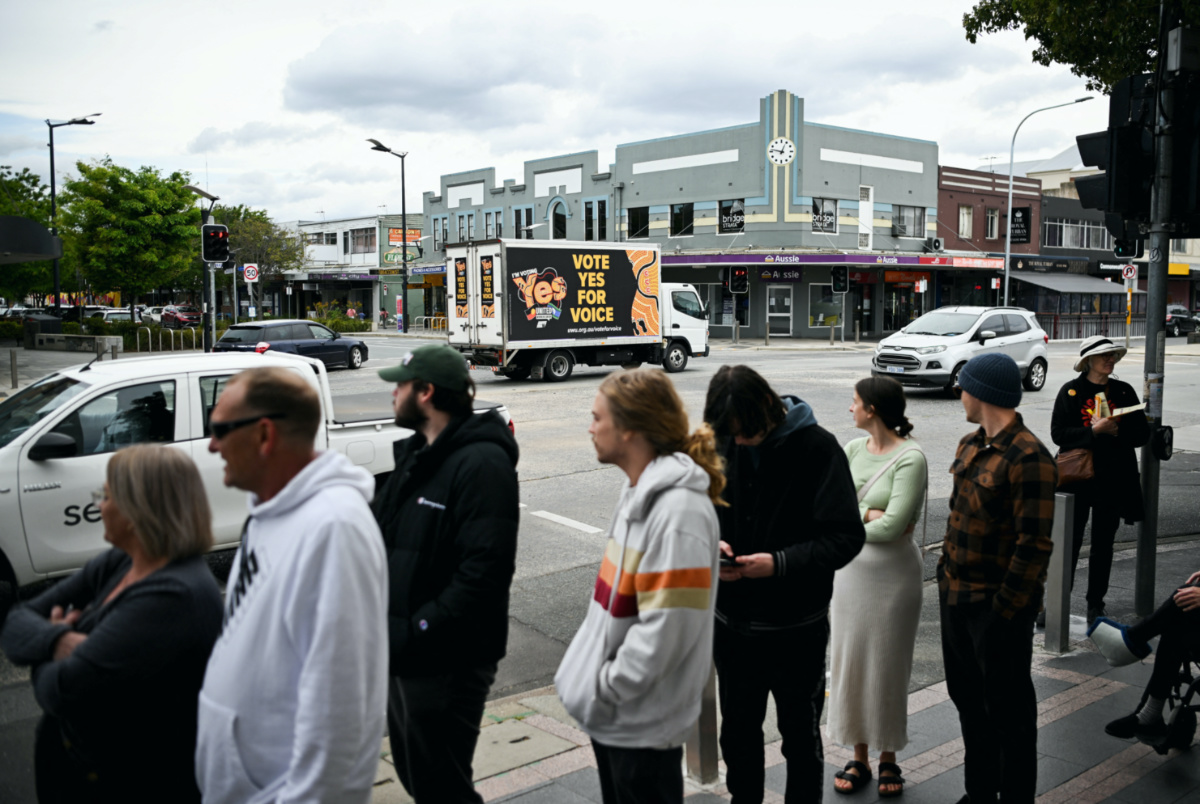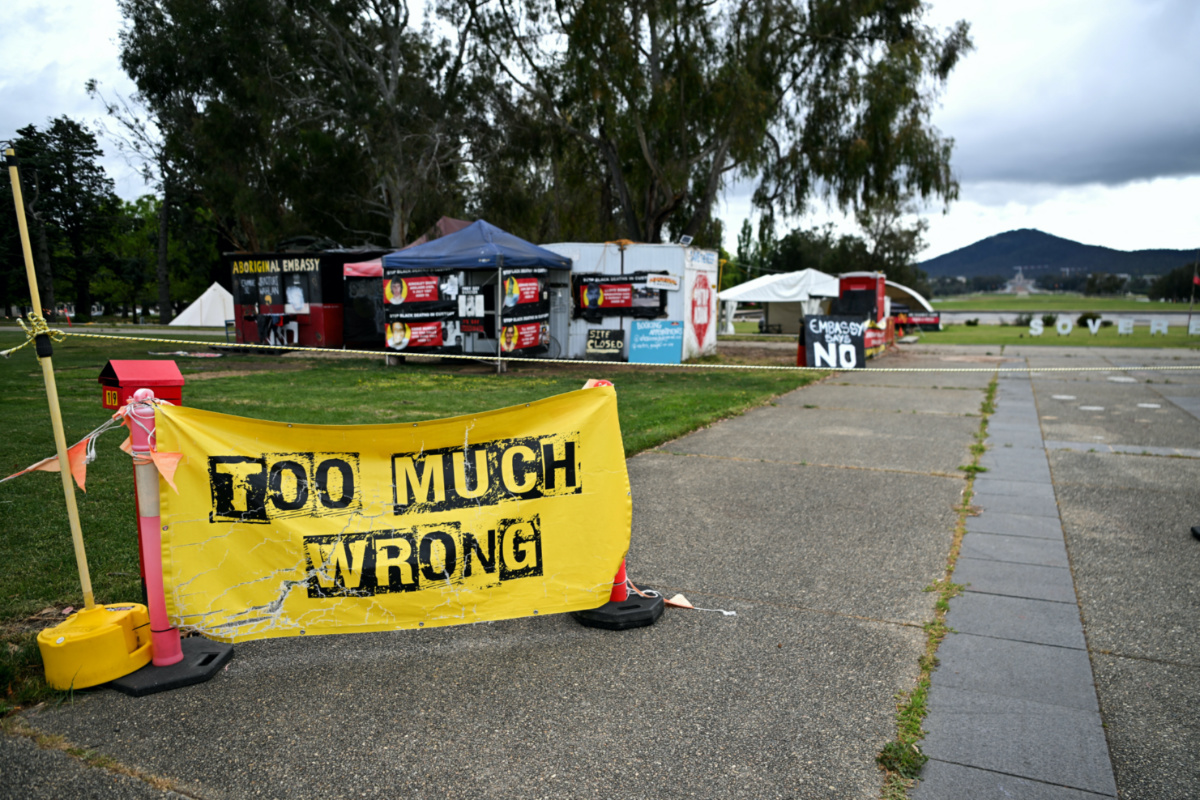Sydney, Australia
Reuters
Upbeat polls and big-name endorsements greeted Australia’s referendum campaign for Indigenous reconciliation when it kicked off in earnest just seven months ago, raising hopes for a historic change to the constitution.
But by the time votes were counted this weekend in the country’s first referendum in nearly 25 years, the proposal for a permanent but non-voting “Indigenous Voice” in parliament had been dragged to a resounding defeat, dead by a thousand political cuts.

‘Yes’ campaigners drive past voters lining up at a polling booth during The Voice referendum in Queanbeyan, Australia, on 14th October, 2023. PICTURE: Reuters/Tracey Nearmy
The centre-left Labor government of Prime Minister Anthony Albanese, acting on a campaign promise from last year’s general election, crafted the plan along lines requested by elders of the Indigenous community, which makes up 3.8 per cent of Australia’s 26 million population.
But without advance buy-in from the opposition party for what had been anticipated as a unifying proposal, the “Voice” became vulnerable to misinformation, race-based suspicion and political indifference, which opponents exploited to turn voters against it.
“Initially it was a proposition that seemed to a lot of Australians to be above politics,” said Kos Samaras, a former strategist for the Labor party who now runs a political consultancy, Redbridge Group.
“Once the bipartisanship was gone and there was significant formal opposition to it…that then bought it down into the political cesspit.”
As academics and analysts sort through the wreckage of the failed vote, they point to a variety of data on past referendums and recent social media trends that show both the under-appreciated obstacles the campaign faced, and how the ground has shifted for political battles in increasingly divided societies.
Matt Qvortrup, a visiting professor of constitutional law at Australian National University who studies referendums, said such campaigns start with an average 55.9% of voters in favour but lose seven percentage points if they are not supported by both sides of parliament.
“Everybody has to know that politics is compromise,” he said, adding that some voters will also typically peel off when they examine the proposal in more detail.
The impact of partisan politics on the referendum played out in particularly dramatic form on social media.
Among posts on the social media platform X, formerly known as Twitter, those in favour of the “Voice” continuously outnumbered posts against it before the opposition Liberal Party leader Peter Dutton formalised his party’s stance on 5th April.
Posts advocating a “Yes” vote jumped more than 500 per cent the next day as “Voice” supporters criticised Dutton, but those advocating “No” gained momentum and five weeks later were outnumbering “Yes”, according to a study of 250,000 posts on X by Timothy Graham, a Queensland University of Technology researcher who studies social media.

A ‘No’ sign sits in front of the Tent Embassy near the Old Australian Parliament House as voters arrive during The Voice referendum, in Canberra, Australia, on 14th October, 2023. PICTURE: Reuters/Tracey Nearmy
With the “No” campaign’s popularity building and only a single referendum question to shoot down, conspiracy theories and misinformation spread faster on social media and, ultimately, filtered into the mainstream conversation, Graham added.
The public support and millions of dollars in contributions from Australia’s biggest banks, miners, retailers and other corporations – Qantas decorated three of its aircraft with “Yes23” logos – along with endorsements from sports and entertainment celebrities including Cate Blanchett, Russell Crowe, Chris Hemsworth, Jason Mamoa and even former NBA star Shaquille O’Neal also proved to be a mixed blessing. “[‘Yes’] used ‘successful Australia’ to try to communicate a message of separation, not inclusion, to ‘unsuccessful Australia’,” said Samaras, the political consultant and former Labor Party strategist. He noted similarities with the 2016 votes for U.S. President Donald Trump and Britain’s departure from the European Union.
“Using corporates and celebrities like that was just crazy,” he said.
What’s more, the “Yes” camp’s compelling narrative of human rights and rectifying historical injustices for Indigenous people often got pushed into the background when public discussion turned to rising living costs and inflation.
Wealthier inner-city suburbs mostly backed the change but every outer suburban electoral seat opposed it, because “currently people’s No.1 concern is cost of living”, said Paul Smith, director of government for poll provider YouGov which had predicted defeat.
“The ‘Voice’ was not very high up on people’s list,” Smith said.
We rely on our readers to fund Sight's work - become a financial supporter today!
For more information, head to our Subscriber's page.
But it was a repudiation from Australia’s conservative coalition, the opposition, that proved decisive in the referendum’s failure.
An Australian referendum requires a majority vote in at least four of its six states, as well as nationally. Ultimately, no state supported the “Voice” and the national vote was 40 per cent “Yes” to 60 per cent “No”, according to preliminary counting.
Liberal leader Dutton, who at the time the referendum campaign launched was still consolidating his position as party leader and was reeling from a by-election loss, quickly staked out his party’s opposition to the “Voice”.
He repeatedly questioned the lack of detail on the proposed advisory body, and said it would divide the country by race, introduce more bureaucracy, and not provide practical outcomes.
After the votes were counted, Dutton said his party supported Indigenous reconciliation but he made no mention of an alternative measure. He instead repeated his call to investigate child abuse in the Indigenous community and to audit spending on Indigenous programmes, “so that we can get the money where it’s needed – to those families in regional and remote areas”.
Analysts said Prime Minister Albanese also miscalculated by running with the Indigenous leaders’ plan before consulting and, if necessary, compromising with the opposition.
“He thought the lead was unassailable,” said Australia National University’s Qvortrup.
Albanese, asked on Saturday why the vote had failed, said no referendum had succeeded without bipartisan support.
“Changing the constitution is hard,” he said. “There are no guarantees of success.”






